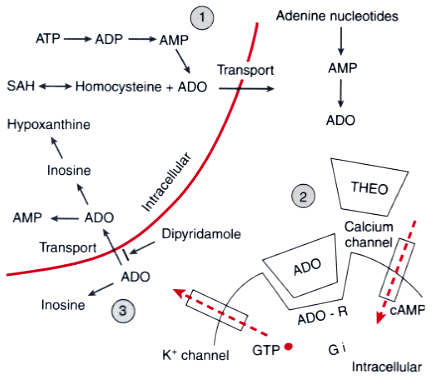Figure 78-6
The cardiac adenosine system is composed of three components:
(1) formation, (2) receptor complex effects, and (3) degradation. (1) Adenosine
(ADO) can be formed intracellularly through the adenosine triphosphate (ATP) or S-adenosylhomocysteine
(SAH) pathway or extracellularly by breakdown of adenosine nucleotides. (2) The
adenosine receptor (ADO-R) is coupled to ion channels by means of guanine-binding
regulatory proteins (G i). Theophylline (THEO) derivatives act as competitive antagonists
for adenosine receptors. (3) ADO can be transported into the cell and then degraded
by deamination to inosine or phosphorylated to adenosine monophosphate (AMP). Dipyridamole
can block the cellular uptake of ADO, thus prolonging its effect. ADP, adenosine
diphosphate, cAMP, cyclic AMP; GTP, guanosine triphosphate. (Redrawn with
modification from Bertolet BD, Hill JA: Adenosine: Diagnostic and therapeutic uses
in cardiovascular medicine. Chest 104:1860, 1993.)

